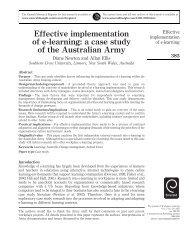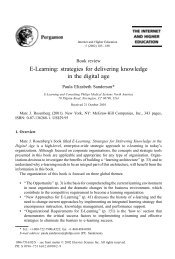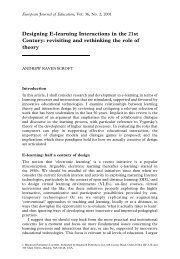E-learning: a performance appraisal and some suggestions for ...
E-learning: a performance appraisal and some suggestions for ...
E-learning: a performance appraisal and some suggestions for ...
Create successful ePaper yourself
Turn your PDF publications into a flip-book with our unique Google optimized e-Paper software.
E-<strong>learning</strong>: a<br />
<strong>per<strong>for</strong>mance</strong> <strong>appraisal</strong><br />
<strong>and</strong> <strong>some</strong> <strong>suggestions</strong><br />
<strong>for</strong> improvement<br />
Peter Honey<br />
The author<br />
Peter Honey is an author, management consultant <strong>and</strong><br />
lifelong learner. He is the founder of Peter Honey<br />
Learning, Maidenhead, UK.<br />
Keywords<br />
Learning styles, Learning, World Wide Web,<br />
Electronic mail<br />
Abstract<br />
Reflects on e-<strong>learning</strong> with respect to other <strong>for</strong>ms of<br />
<strong>learning</strong> <strong>and</strong> endeavours to put it into perspective given<br />
the extent to which it is currently being hyped. Appraises<br />
e-<strong>learning</strong> from the point of view of the learner given<br />
certain assumptions. Attempts to provide a balanced<br />
picture of the pros <strong>and</strong> cons of e-<strong>learning</strong>. Contends that<br />
the e-<strong>learning</strong> industry is overselling its merits <strong>and</strong> not<br />
focusing appropriately on the learner's needs. Concludes<br />
with <strong>some</strong> practical <strong>suggestions</strong> <strong>for</strong> improving e-<strong>learning</strong><br />
<strong>per<strong>for</strong>mance</strong> <strong>and</strong> acceptance.<br />
Electronic access<br />
The research register <strong>for</strong> this journal is available at<br />
http://www.mcbup.com/research_registers<br />
The current issue <strong>and</strong> full text archive of this journal is<br />
available at http://www.emerald-library.com/ft<br />
The Learning Organization<br />
Volume 8 . Number 5 . 2001 . pp. 200±202<br />
MCB University Press . ISSN 0969-6474<br />
200<br />
E-<strong>learning</strong>, in its current <strong>for</strong>m, has been with us<br />
now <strong>for</strong> two or three years preceded by CBT)<br />
<strong>and</strong> enthusiasm from government, organisations<br />
<strong>and</strong> providers shows no signs of abating. The<br />
hype is such that we could all be <strong>for</strong>given <strong>for</strong><br />
thinking that e-<strong>learning</strong> is the equivalent of<br />
manna from heaven ± a timely, life-saving<br />
miracle <strong>for</strong> which we should all be deferentially<br />
grateful. The claims made <strong>for</strong> the effectiveness<br />
of e-<strong>learning</strong>, in particular the sheer convenience<br />
of delivering it to where people are as opposed<br />
to expecting them to come to it), make<br />
e-<strong>learning</strong> sound as if it is ``The Answer'' with<br />
other <strong>for</strong>ms of <strong>learning</strong> suddenly being ridiculed<br />
as clumsy, old fashioned <strong>and</strong> expensive.<br />
One of the problems with appraising<br />
e-<strong>learning</strong> is that it is eclectic the ``e'' is not only<br />
<strong>for</strong> electronic!). You can, <strong>for</strong> example, learn<br />
from surfing the Web, learn by conducting a<br />
focused search on a particular topic, learn by<br />
sending <strong>and</strong> receiving e-mails, learn by dipping<br />
intoanonlinecourse,learnfromparticipatingin<br />
an online discussion <strong>for</strong>um <strong>and</strong> learn by being<br />
coached or mentored via e-mail. The common<br />
thread running through all these <strong>for</strong>ms of e-<br />
<strong>learning</strong> is that they offer the possibility of<br />
<strong>learning</strong> from in<strong>for</strong>mation delivered to us<br />
electronically. The electronic technology<br />
makes more in<strong>for</strong>mation more easily accessible<br />
morecheaplythan everbe<strong>for</strong>e.Itisthe potential<br />
this has <strong>for</strong> boosting both the quantity <strong>and</strong><br />
quality of <strong>learning</strong> in schools, workplaces <strong>and</strong><br />
homes that has created an unprecedented<br />
groundswell of excitement <strong>and</strong> exhortation.<br />
Amidst all this excitement we need to<br />
remember that e-<strong>learning</strong> is fundamentally<br />
another <strong>learning</strong> opportunity, the latest<br />
addition to what is already a long list of<br />
opportunities. For example, we can learn by:<br />
. going at risk <strong>and</strong> experimenting;<br />
. trying <strong>some</strong>thing new <strong>and</strong> different;<br />
. reflecting on an experience;<br />
.<br />
making mistakes or successes or from<br />
anything in between);<br />
. having interactions, exchanges <strong>and</strong><br />
dialogues;<br />
. participating in courses, seminars <strong>and</strong><br />
conferences;<br />
. making visits <strong>and</strong> benchmarking;<br />
. giving <strong>and</strong> receiving feedback;<br />
.<br />
reading books, journals, reports <strong>and</strong><br />
newspapers;<br />
. observing <strong>and</strong> then imitating skills<br />
displayed by other people;<br />
# Peter Honey Learning
E-<strong>learning</strong>: a <strong>per<strong>for</strong>mance</strong> <strong>appraisal</strong> <strong>and</strong> <strong>some</strong> <strong>suggestions</strong><br />
Peter Honey<br />
The Learning Organization<br />
Volume 8 . Number 5 . 2001 . 200±202<br />
. watching TV or a video;<br />
. listening to the radio; <strong>and</strong><br />
.<br />
being coached or mentored.<br />
Now, despite many of these <strong>learning</strong><br />
opportunities being grossly under-utilised, we<br />
need to add e-<strong>learning</strong>.<br />
Certainly <strong>learning</strong> opportunities, besides<br />
being plentiful, are extraordinarily diverse.<br />
Some are relatively passive <strong>and</strong> others are more<br />
active. Some are proactive <strong>and</strong> others are<br />
reactive. Some are <strong>for</strong>mal <strong>and</strong> <strong>some</strong> are<br />
in<strong>for</strong>mal. Some are nice <strong>and</strong> <strong>some</strong> are nasty.<br />
Some are planned <strong>and</strong> <strong>some</strong> are unplanned.<br />
Some are incremental <strong>and</strong> <strong>some</strong> are<br />
trans<strong>for</strong>mational. Some are off-the-job <strong>and</strong><br />
<strong>some</strong> are work-based. And now <strong>some</strong> are<br />
virtual <strong>and</strong> <strong>some</strong> are real. When it comes to<br />
<strong>learning</strong> opportunities, we are spoilt <strong>for</strong> choice!<br />
Thinking about <strong>learning</strong> ``in the round'' like<br />
this helps to put e-<strong>learning</strong> into perspective <strong>and</strong><br />
reminds us that it is not the panacea that <strong>some</strong><br />
exaggerated claims might have us believe.<br />
I want to appraise the <strong>per<strong>for</strong>mance</strong> of<br />
e-<strong>learning</strong> from the consumer's point of view<br />
± a sort of upward <strong>appraisal</strong> if you like. I fully<br />
appreciate the reasons why the government<br />
are keen, why organisations are keen <strong>and</strong>, of<br />
course, why providers are keen to promote<br />
e-<strong>learning</strong>. But the people who really matter<br />
in all this are the learners ± the real customers<br />
<strong>for</strong> e-<strong>learning</strong> ± the people who will vote with<br />
their feet if it fails to meet their needs.<br />
In order to remain focused on e-<strong>learning</strong>'s<br />
<strong>per<strong>for</strong>mance</strong> to date <strong>and</strong> not get side-tracked,<br />
we need to clear the decks by making <strong>some</strong><br />
assumptions. There are eight of them.<br />
1) Let us assume that the technology works. It<br />
would be tempting but unfair to blame e-<br />
<strong>learning</strong> <strong>for</strong> computer crashes <strong>and</strong> the like.<br />
2) Let us assume that everyone has access to<br />
the Internet <strong>and</strong>/or an intranet. This, as<br />
we know, is not yet the case, but, vital<br />
though it is, the provision of the necessary<br />
equipment <strong>and</strong> resources is clearly<br />
beyond the remit of e-<strong>learning</strong>.<br />
3) Let us assume that everyone has basic IT<br />
skills <strong>and</strong> knows how to use the<br />
equipment. This is as much a prerequisite<br />
<strong>for</strong> e-<strong>learning</strong> as being able to<br />
read <strong>and</strong> write is <strong>for</strong> producing an essay.<br />
4) Let us assume that lifelong <strong>learning</strong> is of<br />
the utmost importance <strong>for</strong> the wellbeing<br />
of the nation, communities, organisations<br />
<strong>and</strong> individuals. This assumption<br />
liberates us from the need to repeat all the<br />
201<br />
reasons why <strong>learning</strong> is a priority. The<br />
arguments are well known ± maintaining<br />
a competitive edge, adapting to<br />
unprecedented change, avoiding skill<br />
shortages, remaining employable, leading<br />
a fulfilled life ± to mention but a few.<br />
5) Let us assume that everyone is <strong>learning</strong> all<br />
the time, mostly in<strong>for</strong>mally from life's<br />
rich tapestry with no conscious <strong>learning</strong><br />
intent, <strong>and</strong> occasionally <strong>for</strong>mally from<br />
activities, such as courses, that carry an<br />
explicit <strong>learning</strong> label. This assumption,<br />
incidentally, means that it is nonsense to<br />
describe anyone as a non-learner<br />
government please note!).<br />
6) Let us assume that <strong>learning</strong> is a process a<br />
learnable process) with many outcomes. It<br />
is the means whereby we acquire<br />
knowledge, skills, insights, beliefs, values,<br />
attitudes, habits, feelings, wisdom, shared<br />
underst<strong>and</strong>ings <strong>and</strong> self-awareness ± a far<br />
from exhaustive list.<br />
7) Let us assume that there is no one right<br />
way to learn, that learners with different<br />
styles, aptitudes <strong>and</strong> backgrounds are<br />
diverse <strong>and</strong> that, as we have seen,<br />
<strong>learning</strong> opportunities are also diverse.<br />
8) Finally, let us assume that e-<strong>learning</strong> is<br />
the process of <strong>learning</strong> from in<strong>for</strong>mation<br />
that is delivered electronically. It leaves<br />
us, the learners, to identify relevant<br />
in<strong>for</strong>mation, convert it into <strong>some</strong>thing<br />
meaningful <strong>and</strong> apply it appropriately in<br />
ways that enhance our <strong>per<strong>for</strong>mance</strong>.<br />
So, let us examine e-<strong>learning</strong>, at what might be<br />
considered to be the end of its probationary<br />
period, <strong>and</strong> appraise its <strong>per<strong>for</strong>mance</strong>.<br />
We need to start by praising e-<strong>learning</strong> <strong>for</strong><br />
the vast depository of in<strong>for</strong>mation that has<br />
been amassed in a relatively short time. This<br />
is extraordinarily impressive. There are online<br />
courses on every subject under the sun <strong>and</strong><br />
ready access to the Internet with its<br />
unimaginably large database. In fact, the<br />
database is growing so fast it is estimated that<br />
the in<strong>for</strong>mation on the Internet doubles every<br />
three months) as providers rush to offer what<br />
were previously classroom courses <strong>and</strong> paperbased<br />
materials online, that e-<strong>learning</strong> is<br />
becoming ``obese''. E-<strong>learning</strong> provides the<br />
equivalent of an Aladdin's cave stacked high<br />
with parcels of in<strong>for</strong>mation <strong>and</strong> ``<strong>learning</strong><br />
objects''. It is an electronic version of ``Pile<br />
`em high. Sell `em cheap!'' Of course locating<br />
relevant subject matter on such a vast
E-<strong>learning</strong>: a <strong>per<strong>for</strong>mance</strong> <strong>appraisal</strong> <strong>and</strong> <strong>some</strong> <strong>suggestions</strong><br />
Peter Honey<br />
database is the modern day equivalent of<br />
searching <strong>for</strong> a needle in a haystack.<br />
One of e-<strong>learning</strong>'s strongest characteristics<br />
is its accessibility. Its ``Anywhere, any time, any<br />
place'' slogan is no exaggeration. It is just a click<br />
away whenever you need it, in sociable or<br />
unsociable hours, at work or at home. But,<br />
paradoxically, e-<strong>learning</strong>'s high accessibility<br />
means that its supporters tend to be naõÈve about<br />
the learner's circumstances. They assume that<br />
learners are motivated <strong>and</strong> expect them to<br />
match this accessibility. They ignore other<br />
dem<strong>and</strong>s <strong>and</strong> pressures <strong>and</strong> the problems of<br />
finding the time <strong>and</strong> space <strong>for</strong> e-<strong>learning</strong>. A<br />
recent survey conducted by The Campaign <strong>for</strong><br />
Learning 2000) found that 58 per cent of<br />
people attempt to e-learn at their desks <strong>and</strong> 29<br />
per cent do it at home. Expecting busy people<br />
to have the self-discipline to concentrate on e-<br />
<strong>learning</strong> in what amounts to discretionary time<br />
is unrealistic <strong>and</strong> naõÈve. Even people who ``rate''<br />
<strong>learning</strong> <strong>and</strong> consider it important, are likely to<br />
find that ``Any time'' too easily becomes ``Not<br />
now ... maybe later''. A clear case of the spirit<br />
being willing, but the flesh being weak.<br />
E-<strong>learning</strong> certainly does make it easy <strong>for</strong><br />
you to network, <strong>and</strong> learn from, people you<br />
would never otherwise reach. It can put you in<br />
touch with people all over the world. You can<br />
quiz Harvard professors by e-mail, join an<br />
online discussion <strong>for</strong>um, find yourself an<br />
e-coach or mentor, receive electronic<br />
newsletters from fellow professionals in farflung<br />
parts of the globe.<br />
Although e-<strong>learning</strong> offers a multi-media<br />
approach, blending text with graphics, video<br />
clips <strong>and</strong> music to make it more appealing <strong>and</strong><br />
entertaining, un<strong>for</strong>tunately this versatility is<br />
not always practical because of b<strong>and</strong>width<br />
constraints <strong>and</strong> complaints about unacceptably<br />
long download times. These restrictions on e-<br />
<strong>learning</strong> versatility inevitably mean that it tends<br />
to be boring. Too often e-<strong>learning</strong> simply<br />
regurgitates pages of text culled from books<br />
<strong>and</strong> classroom courses. E-<strong>learning</strong> more often<br />
than not amounts to e-reading.<br />
Un<strong>for</strong>tunately, all these potential benefits are<br />
going to the collective heads of the e-<strong>learning</strong><br />
industry's developers <strong>and</strong> vendors who are alike<br />
becoming increasingly arrogant. The industry<br />
behaves as if it ``knows best'' <strong>and</strong> is dismissive<br />
of other <strong>for</strong>ms of <strong>learning</strong>. It has made the<br />
mistake of falling <strong>for</strong> its own PR <strong>and</strong> has<br />
become convinced that single-h<strong>and</strong>edly its<br />
members will trans<strong>for</strong>m the world of <strong>learning</strong>.<br />
Despite claims to the contrary, there is a<br />
tendency to be didactic rather than involving,<br />
preferring to tell rather than ask. This stems<br />
from the conviction that in<strong>for</strong>mation is king<br />
<strong>and</strong> that <strong>learning</strong> is achieved by dispensing<br />
large quantities of it. This conveniently ignores<br />
the yawning gap between knowing <strong>and</strong> doing.<br />
Finally e-<strong>learning</strong> developers are too<br />
engrossed in pushing in<strong>for</strong>mation at the<br />
student to care about the individual's needs as<br />
a learner. No interest is shown in <strong>learning</strong> style<br />
preferences or in helping the person to<br />
improve his/her skills as a learner. Despite the<br />
fact that one of the strengths of electronic<br />
technology is its ability to customise,<br />
e-<strong>learning</strong> continues to assume that one-sizefits-all.<br />
In The Campaign <strong>for</strong> Learning's survey<br />
The Campaign <strong>for</strong> Learning, 2000), 43 per<br />
cent of employers claimed that the e-<strong>learning</strong><br />
they offered was tailored to individual needs<br />
but only 7 per cent of learners agreed.<br />
Suggestions <strong>for</strong> improvement<br />
E-<strong>learning</strong> is like a curate's egg ± good in<br />
parts! It clearly has plenty of potential <strong>and</strong> is a<br />
welcome addition to a long <strong>and</strong> varied list of<br />
<strong>learning</strong> opportunities. However, there is<br />
certainly room <strong>for</strong> improvement ± here are<br />
four <strong>suggestions</strong>:<br />
1) Stop pushing text down a telephone line<br />
<strong>and</strong> calling it <strong>learning</strong>.<br />
2) Have more sympathy <strong>for</strong> the learner's<br />
situation. It is unrealistic to expect busy<br />
people to be sufficiently motivated <strong>and</strong><br />
disciplined to learn at their desks in what<br />
is effectively discretionary time. Learning<br />
has always flourished when it has been<br />
actively encouraged <strong>and</strong> supported.<br />
3) Stop behaving as if e-<strong>learning</strong> is ``The<br />
Answer'', a panacea. Work out the<br />
distinctive competence of the e-<strong>learning</strong><br />
approach the sort of <strong>learning</strong> that<br />
e-<strong>learning</strong> is uniquely equipped to help<br />
with) <strong>and</strong> how best to complement other<br />
<strong>for</strong>ms of <strong>learning</strong>.<br />
4) Show far more interest in <strong>learning</strong> as a<br />
process <strong>and</strong> in how to tailor in<strong>for</strong>mation<br />
to meet the needs of learners with<br />
different <strong>learning</strong> styles. Ask questions to<br />
establish the <strong>learning</strong> preferences of<br />
students <strong>and</strong> use the e-technology to<br />
customise offerings accordingly.<br />
Reference<br />
The Learning Organization<br />
Volume 8 . Number 5 . 2001 . 200±202<br />
The Campaign <strong>for</strong> Learning 2000), Attitudes to E-<strong>learning</strong>: A<br />
National Survey 2000, Southgate Publishers, S<strong>and</strong><strong>for</strong>d.<br />
202
















